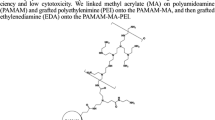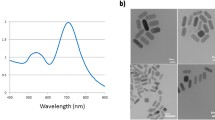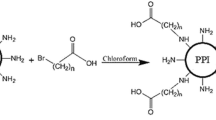Abstract
Purpose
Application of combinatorial chemistry and high throughput screening for the synthesis and evaluation of mini-library of novel biodegradable poly (β-amino ester)s (PAE)s composed of γ-aminopropyl-triethoxysilane (APES) and poly (ethylene glycol) diacrylate (PEGDA) for gene delivery efficiency and safety in 293T and HeLa cells in the presence of and absence of serum.
Materials and methods
PAEs were synthesized at different mole ratios of APES and PEGDA by Michael addition reaction and synthesis was confirmed by 1H nuclear magnetic resonance (1H-NMR). Ninety six ratios of polyplexes were evaluated for luciferase and MTS assay in 293T and HeLa cells in the presence of and absence of serum. Relationship between transfection efficiency and DNA binding ability of PAEs was studied by gel electrophoresis. Particle sizes and molecular weight of selected PAEs were measured by dynamic light scattering and gel permeation chromatography multi-angle light scattering, respectively.
Results
1H-NMR confirmed the synthesis of PAEs. In both cell lines, transfection efficiency and cell viability were increased for PAEs obtained from R106 (0.7:1, APES:PEGDA) to R121 (6:1, APES:PEGDA) with a marginal increase in APES concentration. Transfection pattern was uniform in the absence of and presence of serum. In both cell lines, PAE obtained from R121 demonstrated high transfection efficiency and low cytotoxicity as compared to polyethylenimine (25 KDa) and Lipofectamine. PAE obtained from R121 showed good DNA binding and condensation with average particle sizes of 133 nm.
Conclusion
Addition of PEGDA over APES resulted in a novel PAE which has high safety and transfection efficiency. Transfection and cytotoxicity are very sensitive to monomer ratios and mainly governed by concentration of amine monomer.







Similar content being viewed by others
Abbreviations
- AEAPMS:
-
N-β-(aminoethyl)-γ-aminopropyl-trimethoxysilane
- APES:
-
γ-aminopropyl-triethoxysilane
- DMEM:
-
Dulbaco’s modified Eagles media
- PAE:
-
poly (β-amino ester)
- PEGDA:
-
poly (ethylene glycol) diacrylate
- PEI 25K:
-
high molecular weight polyethylenimine (25 KDa)
- RLU/mg protein:
-
Relative light units per milligram of protein
- R106 to R121:
-
reaction codes representing PAEs obtained from different mole ratios of APES and PEGDA
References
L. H. M.-C. H. E. Wagner. Nonviral Vectors for Gene Delivery, Academic Press, New York, 1999.
Y. Liu, D. Wu, Y. Ma, G. Tang, S. Wang, C. He, T. Chung, and S. Goh. Novel poly(amino ester)s obtained from Michael addition polymerizations of trifunctional amine monomers with diacrylates: safe and efficient DNA carriers. Chem. Commun. 2630–2631 (2003).
A. Akinc, D. M. Lynn, D. G. Anderson, and R. Langer. Parallel synthesis and biophysical characterization of a degradable polymer library for gene delivery. J. Am. Chem. Soc. 125:5316–5323 (2003).
J. H. Lee, Y. B. Lim, J. S. Choi, Y. Lee, T. I. Kim, H. J. Kim, J. K. Yoon, K. Kim, and J. S. Park. Polyplexes assembled with internally quaternized PAMAM-OH dendrimer and plasmid DNA have a neutral surface and gene delivery potency. Bioconjug. Chem. 14:1214–1221 (2003).
O. Boussif, F. Lezoualc’h, M. A. Zanta, M. D. Mergny, D. Scherman, B. Demeneix, and J. P. Behr. A versatile vector for gene and oligonucleotide transfer into cells in culture and in vivo: polyethylenimine. Proc. Natl. Acad. Sci. U. S. A. 92:7297–7301 (1995).
D. W. Pack, A. S. Hoffman, S. Pun, and P. S. Stayton. Design and development of polymers for gene delivery. Nat. Rev. Drug Discov. 4:581–593 (2005).
K. C. Cho, S. H. Kim, J. H. Jeong, and T. G. Park. Folate receptor-mediated gene delivery using folate-poly(ethylene glycol)-poly(L-lysine) conjugate. Macromol. Biosci. 5:512–519 (2005).
E. M. Kim, H. J. Jeong, I. K. Park, C. S. Cho, H. S. Bom, and C. G. Kim. Monitoring the effect of PEGylation on polyethylenimine in vivo using nuclear imaging technique. Nucl. Med. Biol. 31:781–784 (2004).
Y. H. Choi, F. Liu, J. S. Park, and S. W. Kim. Lactose-poly(ethylene glycol)-grafted poly-L-lysine as hepatoma cell-targeted gene carrier. Bioconjug. Chem. 9:708–718 (1998).
C. Kneuer, M. Sameti, E. G. Haltner, T. Schiestel, H. Schirra, H. Schmidt, and C. M. Lehr. Silica nanoparticles modified with aminosilanes as carriers for plasmid DNA. Int. J. Pharm. 196:257–261 (2000).
Z. Li, S. Zhu, K. Gan, Q. Zhang, Z. Zeng, Y. Zhou, H. Liu, W. Xiong, X. Li, and G. Li. Poly-L-lysine-modified silica nanoparticles: a potential oral gene delivery system. J. Nanosci. Nanotechnol. 5:1199–1203 (2005).
M. Sameti, G. Bohr, M. N. Ravi Kumar, C. Kneuer, U. Bakowsky, M. Nacken, H. Schmidt, and C. M. Lehr. Stabilisation by freeze-drying of cationically modified silica nanoparticles for gene delivery. Int. J. Pharm. 266:51–60 (2003).
D. Luoand, and W. M. Saltzman. Enhancement of transfection by physical concentration of DNA at the cell surface. Nat. Biotechnol. 18:893–895 (2000).
M. Thomasand and A. M. Klibanov. Conjugation to gold nanoparticles enhances polyethylenimine’s transfer of plasmid DNA into mammalian cells. Proc. Natl. Acad. Sci. U. S. A. 100:9138–9143 (2003).
E. H. Chowdhury, M. Kunou, M. Nagaoka, A. K. Kundu, T. Hoshiba, and T. Akaike. High-efficiency gene delivery for expression in mammalian cells by nanoprecipitates of Ca–Mg phosphate. Gene 341:77–82 (2004).
D. J. Bharali, I. Klejbor, E. K. Stachowiak, P. Dutta, I. Roy, N. Kaur, E. J. Bergey, P. N. Prasad, and M. K. Stachowiak. Organically modified silica nanoparticles: a nonviral vector for in vivo gene delivery and expression in the brain. Proc. Natl. Acad. Sci. U. S. A. 102:11539–11544 (2005).
D. Luo, E. Han, N. Belcheva, and W. M. Saltzman. A self-assembled, modular DNA delivery system mediated by silica nanoparticles. J. Control. Release 95:333–341 (2004).
B. D. Mather, K. Viswanathan, K. M. Miller, and T. E. Long. Michael addition reactions in macromolecular design for emerging technologies. Prog. Polym. Sci. 31:487–531 (2006).
D. Jere, R. Arote, H. Jiang, J. W. Nah, M. H. Cho, and C. S. Cho. A poly(β-amino ester) of spermine and poly(ethylene glycol) diacrylate as a gene carrier. Key Eng. Mater. 342–343:425–428 (2007).
T. H. Kim, S. E. Cook, R. Arote, M. H. Cho, J. W. Nah, Y. J. Choi, and C. S. Cho. A degradable hyperbranched poly(ester amine) based on poloxamer diacrylate and polyethylenimine as a gene carrier. Macromol. Biosci. 7:611–619 (2007).
R. Arote, T. H. Kim, Y. K. Kim, S. K. Hwang, H. L. Jiang, H. H. Song, J. W. Nah, M. H. Cho, and C. S. Cho. A biodegradable poly(ester amine) based on polycaprolactone and polyethylenimine as a gene carrier. Biomaterials 28:735–744 (2007).
N. D. Sonawane, F. C. Szoka, Jr., and A. S. Verkman. Chloride accumulation and swelling in endosomes enhances DNA transfer by polyamine-DNA polyplexes. J. Biol. Chem. 278:44826–44831 (2003).
M. R. Park, K. O. Han, I. K. Han, M. H. Cho, J. W. Nah, Y. J. Choi, and C. S. Cho. Degradable polyethylenimine-alt-poly(ethylene glycol) copolymers as novel gene carriers. J. Control. Release 105:367–380 (2005).
D. G. Anderson, A. Akinc, N. Hossain, and R. Langer. Structure/property studies of polymeric gene delivery using a library of poly(beta-amino esters). Molec. Ther. 11:426–434 (2005).
F. Meng, G. H. Engbers, and J. Feijen. Polyethylene glycol-grafted polystyrene particles. J. Biomed. Mater. Res. A. 70:49–58 (2004).
A. Akinc, D. G. Anderson, D. M. Lynn, and R. Langer. Synthesis of poly(beta-amino ester)s optimized for highly effective gene delivery. Bioconjug. Chem. 14:979–988 (2003).
Acknowledgements
This work is funded by Korea Research Foundation (D00248). We also acknowledge National Instrumental Centre for Environmental Management for measurement of NMR and particle size. Mr. Dhananjay Jere is supported by Korea Research Foundation.
Author information
Authors and Affiliations
Corresponding author
Rights and permissions
About this article
Cite this article
Jere, D., Yoo, MK., Arote, R. et al. Poly (amino ester) Composed of Poly (ethylene glycol) and Aminosilane Prepared by Combinatorial Chemistry as a Gene Carrier. Pharm Res 25, 875–885 (2008). https://doi.org/10.1007/s11095-007-9448-4
Received:
Accepted:
Published:
Issue Date:
DOI: https://doi.org/10.1007/s11095-007-9448-4




